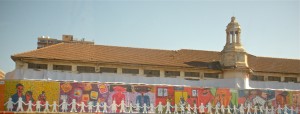
The KwaZulu-Natal Children’s Hospital Restoration Project
This past July, with funding from an SSHRC Image, Text, Sound & Technology “Curating Difficult Knowledge” team grant (on which I am a co-applicant with Concordia’s Erica Lehrer, Joseph Rosen, Chris Salter, and Jason Lewis, as well as Université de Montréal’s Cynthia Milton), I spent six weeks in South Africa conducting research and reconnecting with people and places. I had not been in South Africa since my almost three year stint of archival research and ethnographic fieldwork for my dissertation. In Durban, I had the chance to learn about the exciting restoration project for the KwaZulu-Natal Children’s Hospital.
The first children’s hospital in South Africa, it opened —to white children— in 1931. But in the early 1970s, tensions between the verlichte (Afrikaans for “enlightened”) Children’s Hospital Workers and the verkrampte (closed-minded, cramped) pro-apartheid establishment began to play out in intra-institutional battles over the relationship between the Durban Children’s Hospital and the adjacent general Addington Hospital. The hospital closed its doors at the height of apartheid violence in 1984. With its period artwork and architecture, the Hospital has been recognized by the Architectural Heritage Trust and AMAFA, the provincial heritage conservation agency for KwaZulu Natal as an important heritage site. Of particular interest and importance to heritage conservationists—and to me with my concern with the possibilities for innovative curation— is the presence of a small museum in the historic Nurses’ quarters.
When I became aware of interest in preserving and updating the museum space in the overall renovation, it struck me as an ideal opportunity for an important intervention at the intersection of a number of issues. The venue is an ideal place to address the under-acknowledged and oversimplified history of childhood in South Africa. This is a history of violence, of racism, of lack and loss, but also resilience and agency. Though disregarded now by many as the so-called “lost generation,” South African children and youth were pivotal in toppling the apartheid regime, and more recently, in serving as international spokespeople in the broader discourse on human—and specifically children’s rights. It also offers a unique and powerful opportunity to do pressing, collaborative public work in a country where important debates continue to rage within various domains of public life about the violence of apartheid and its legacies in the present.
Museums and monuments in South Africa traditionally celebrated apartheid and its beneficiaries, while demonizing, belittling, or ignoring the black majority population. Attempts to democratize such sites in terms of both access and content are challenging, not least due to continuing hostility and prejudice across racial and class lines. But by using the institutional space of the hospital museum to explore some of the complexities around the roles, experiences, and participation of children in South African society, the difficult task of entrenching a new, human rights-based moral economy can be pushed forward in a small way – and offer a model for further collaborative representational experiments.
The KwaZulu-Natal province has the highest rate of HIV infection in South Africa (estimated to be around 30%). Many of these cases are children. With its primary constituency—black, poor, sick children on the bottom of multiple hierarchies – how can the Children’s Hospital Museum maximize its impact in a current socioeconomic reality that is defined by distribution of resources, available services, and experiences of hardship and suffering that are grossly skewed across “racial” categories?
At this point I have more questions than answers about this very new project, but I was drawn to this space because of its potential as a site of intervention, where the powerful and fraught category of “childhood” can be publicly unpacked and leveraged by and for children. Today’s newly named KwaZulu-Natal Children’s Hospital stands poised to re-envision what a museum—and a children’s hospital—can be. Drawing from the expertise, experience, and hopes of community members, academics, business leaders, members of government, and non-governmental organizations, planners have committed to private-public partnership – a ground-breaking approach in a country in which the quality and basic availability of healthcare is still hugely varied according to race and class. The hospital embodies many of the legacies of apartheid, and its history runs parallel to apartheid’s larger story. As such, it is a significant, and potentially transgressive space for moving beyond those circumstances and their continuing legacies, by taking South African children seriously as not just recipients of advocacy and care but as active participants who should be given the space to not just express themselves but shape the institution and its offerings according to their needs and wishes.
Post by Monica Patterson



